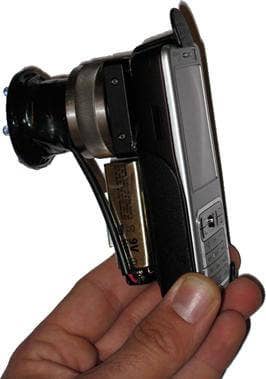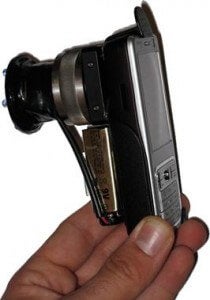CellScope: Your Cell Phone Just Got a Microscope

Share

I think we need to stop calling them cell phones, because our hand held devices are starting to have more capabilities than Batman's utility belt. Controlling robots, projecting images, depositing checks, augmented reality, not to mention internet, GPS, and cameras... and now we can add microscopes to the list. Prof. Dan Flectcher and his team out of UC Berkeley are developing the CellScope, a microscope assembly that will easily attach to a standard cell phone and allow you to take up close images of skin and blood samples. While that sounds like just another cool iPhone trick, it has huge implications for fighting diseases in the Third World. Check out Fletcher's explanation video from Popular Science after the break.
Tuberculosis (TB) and Malaria kill millions each year and infect hundreds of millions more. Most of those infected are miles from a doctor and even farther from reliable medical equipment. This means that many go untreated, and many more may be misdiagnosed. A portable method for sampling blood in the field could literally save millions of lives. CellScope has the potential to do just that. Field personnel with little experience can take a blood sample, image it, then send the photo to a qualified medical professional miles away. Diagnosis by phone might be just what the doctor ordered.
The idea and first prototype for the CellScope came out of a class that Fletcher taught. He challenged his students to create a microscope that could be attached to a cell phone. Now, many of those same students are helping CellScope through the development phase. The current incarnation of the device is still a little bulky (as you can see in the video) but the ultimate goal is a few inches of length and less than one pound in weight.
https://c.brightcove.com/services/viewer/federated_f8/1274171289
Be Part of the Future
Sign up to receive top stories about groundbreaking technologies and visionary thinkers from SingularityHub.


While Malaria can be identified with standard light illumination, TB requires a fluorescent technique. So there is more than one model for the CellScope, including one with 460 nm wavelength light to help diagnosis TB. Other variations to match other diseases are currently in development. It's unclear whether the final device will be a single tube with complicated means of switching lenses and illumination or if a field user will carry several different tubes to match different testing modalities.
While it may revolutionize medicine in remote locations, CellScope could also do the same domestically. Patients with chronic blood conditions or skin diseases could have a powerful new tool at their disposal. They may be able to stay at home and send images to doctors for diagnosis rather than make costly routine visits to hospitals.
It's unclear when CellScope will hit the market and which market (domestic or international medicine) will be approached first. In fact, with all the prototyping and decision making that needs to be done, I'm worried that it may be several years or more before it is widely available.
I should point out that Prof. Dan Fletcher and his crew aren't gadget gurus, they're biophysicists, grad students and undergraduates. Which makes this whole story that much more impressive to me. Kudos to Dr. Fletcher for not just taking time out of research to help people, but for teaching his students to do the same. My own advisor always used to tell me that it wasn't enough to just perform experiments, you had to give back to society as well. Science and social conscience, like remote diagnosis and microscopy, is a powerful combination. Batman would approve.
[photo credits: Fletcher Labs]
Related Articles

This Portable Wind Turbine Is the Size of a Water Bottle and Charges Devices in Under an Hour

Mojo Vision’s New Contact Lens Brings Seamless Augmented Reality a Step Closer
The Weird, the Wacky, the Just Plain Cool: Best of CES 2020
What we’re reading